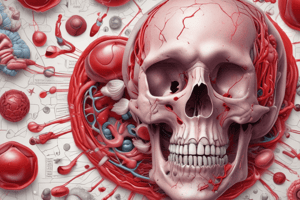Podcast
Questions and Answers
What type of molecule is responsible for the formation of water molecules?
What type of molecule is responsible for the formation of water molecules?
- Covalent bonds
- Ionic bonds
- Van der Waals forces
- Hydrogen bonds (correct)
What is the primary function of ATP in cells?
What is the primary function of ATP in cells?
- To provide energy for cellular processes (correct)
- To provide structural support
- To store genetic information
- To transport molecules across membranes
Which of the following is NOT a function of the skeletal system?
Which of the following is NOT a function of the skeletal system?
- Protects internal organs
- Provides support and structure
- Produces red blood cells
- Regulates body temperature (correct)
Which of the following is NOT a characteristic of a eukaryotic cell?
Which of the following is NOT a characteristic of a eukaryotic cell?
What is the primary function of the digestive system?
What is the primary function of the digestive system?
Flashcards
Eukaryotic cell
Eukaryotic cell
A cell with a nucleus and membrane-bound organelles.
Prokaryotic cell
Prokaryotic cell
A simple, unicellular organism without a nucleus.
ATP
ATP
A molecule that carries energy within cells for metabolism.
Diffusion
Diffusion
Signup and view all the flashcards
Osmosis
Osmosis
Signup and view all the flashcards
Study Notes
Blood Components
- Blood is composed of plasma (liquid portion) and formed elements (cells and cell fragments).
- Plasma is mostly water, containing dissolved proteins, nutrients, wastes, and hormones.
- Formed elements include red blood cells (erythrocytes), which carry oxygen; white blood cells (leukocytes), involved in immunity; and platelets (thrombocytes), essential for clotting.
Muscle Types
- Skeletal muscle: Voluntary muscle attached to bones, responsible for movement.
- Smooth muscle: Involuntary muscle found in internal organs, involved in functions like digestion and blood flow.
- Cardiac muscle: Involuntary muscle found only in the heart, responsible for pumping blood.
Hydrogen Bonding in Water
- Water molecules exhibit hydrogen bonding due to the polar nature of the molecule.
- Oxygen is more electronegative than hydrogen, creating a partial negative charge on oxygen and partial positive charges on hydrogen.
- These partial charges allow hydrogen bonds to form between water molecules.
Eukaryotic Cell
- Eukaryotic cells contain a membrane-bound nucleus and other organelles.
- These organelles include mitochondria, endoplasmic reticulum, Golgi apparatus, and lysosomes, each with specific functions.
Prokaryotic Cell
- Prokaryotic cells lack a nucleus and other membrane-bound organelles.
- They have a simpler structure compared to eukaryotic cells. Examples include bacteria and archaea.
ATP Function
- ATP (adenosine triphosphate) is the primary energy currency of cells.
- It stores and releases energy in the bonds between its phosphate groups.
- ATP is used for various cellular processes, including muscle contraction, active transport, and biosynthesis.
Filtration
- Filtration is a process that separates substances based on size.
- Smaller molecules pass through a membrane, while larger molecules are retained.
Diffusion
- Diffusion is the net movement of molecules from an area of higher concentration to an area of lower concentration.
- This movement occurs passively and continues until equilibrium is established.
Osmosis
- Osmosis is the movement of water across a semipermeable membrane from an area of higher water concentration to an area of lower water concentration.
- The movement of water aims to equalize the concentration of solutes on both sides of the membrane.
Active Transport
- Active transport moves molecules against their concentration gradient.
- This process requires energy (ATP) and a protein transporter.
Animal Cell Anatomy
- Animal cells are surrounded by a plasma membrane.
- Inside the cell, there is a nucleus containing DNA, cytoplasm, and organelles (e.g., mitochondria, ribosomes).
Cellulose Function
- Cellulose is a structural polysaccharide found in plant cell walls.
- It provides rigidity and support to the plant.
Plant Pollination
- Plants are pollinated by various agents, including wind, water, and animals (e.g., insects, birds).
- Different pollination strategies exist, each adapted to the specific plant and pollinators.
Skeletal System Function
- The skeletal system provides support, protection, movement, and blood cell production.
Muscular System Function
- The muscular system facilitates movement, maintains posture, and generates heat.
Respiratory System Function
- The respiratory system facilitates gas exchange (oxygen and carbon dioxide) between the body and the environment.
Cardiovascular System Function
- The cardiovascular system circulates blood throughout the body, delivering oxygen and nutrients to tissues and removing waste products.
Immune System Function
- The immune system defends the body against pathogens and foreign invaders.
Integumentary System Function
- The integumentary system (skin) protects the body from the environment, regulates temperature, and aids in sensory perception.
Endocrine System Function
- The endocrine system controls various bodily functions through the release of hormones.
Nervous System Function
- The nervous system transmits signals throughout the body, allowing for communication between different parts and coordinating responses to stimuli.
Reproductive System Function
- The reproductive system is responsible for creating offspring.
Digestive System Function
- The digestive system breaks down food into absorbable nutrients, and absorbs them into the bloodstream to provide energy to the body.
Studying That Suits You
Use AI to generate personalized quizzes and flashcards to suit your learning preferences.




